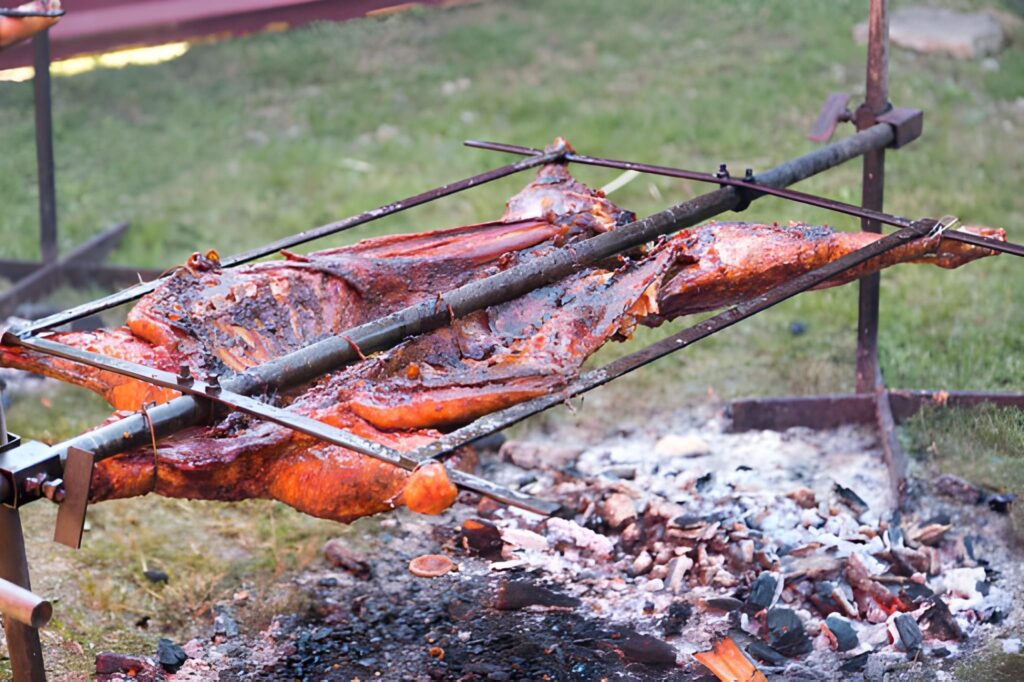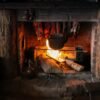A Firelit Hall and the Turning of Meat
Imagine stepping into a medieval great hall. The smell of wood smoke fills the air, torches flicker against stone walls, and long tables groan under the weight of trenchers, cheeses, and pitchers of ale. At the center of it all, near the roaring hearth, meat turns slowly on an iron spit. Servants rotate it carefully, basting it with dripping fat, while nobles glance over, hungry for the centerpiece of the feast.
This scene captures the essence of medieval spit roasting, one of the most dramatic and celebrated cooking methods of the Middle Ages. It wasn’t just about cooking it was performance, ritual, and the heart of communal dining.
Why Medieval Spit Roasting Mattered
Food in the Middle Ages wasn’t just about survival. It was about status, community, and celebration. Spit roasting mattered because it:
-
Made meat the visual and culinary centerpiece of feasts.
-
Showed wealth, since only prosperous households could afford large cuts of meat or entire animals.
-
Brought people together—everyone could smell and see the meat as it turned, a shared sensory experience.
-
Created flavors unmatched by other methods—juices basting the meat as it cooked over open fire.
For kings, lords, and wealthy merchants, spit roasting symbolized power and hospitality. For ordinary people, it was a rare treat, often linked to festivals, weddings, or religious celebrations.
How Medieval Spit Roasting Worked
The Spit
The spit itself was usually a long iron or wooden rod, strong enough to pierce and hold large cuts of meat, sometimes whole animals like boars or deer.
The Fire
Hearth fires in great halls weren’t just for warmth. They were designed for cooking, with embers arranged to create steady, even heat. Meat wasn’t usually roasted directly in flames but over glowing coals.
The Turning
The most laborious part was turning the spit. Before mechanical aids, this was done by servants or even children—often called “spit boys.” Later, mechanical spit-turners (called “roasting jacks”) were introduced, powered by weights, springs, or even trained dogs running in wheels.
The Basting
As fat dripped, cooks basted the meat with its own juices or with spiced sauces. Herbs, vinegar, honey, and ale might be brushed onto add flavor and preserve moisture.
The Presentation
When finally carved and served, spit-roasted meat often arrived dramatically, borne on platters, sometimes still whole, reinforcing the spectacle of medieval dining.
Table: Medieval Spit Roasting Compared to Other Methods
| Cooking Method | Tools Used | Typical Foods Cooked | Cultural Role |
|---|---|---|---|
| Spit Roasting | Iron/wood spit, open fire | Boar, venison, fowl, beef | Feast centerpiece, display of wealth |
| Baking in Ovens | Clay/brick ovens | Bread, pies, pastries | Daily food, bulk cooking |
| Boiling/Stewing | Cauldrons, pots | Soups, pottages, grains | Commoners’ meals, everyday survival |
| Smoking/Drying | Pits, racks, smokehouses | Fish, pork, sausages | Preservation for winter |
Cultural Stories of Spit Roasting
-
Royal Banquets: Chronicles from medieval courts describe entire oxen roasted on spits for coronations and royal weddings. These feasts weren’t just meals; they were propaganda, reinforcing the power of the ruler.
-
Monasteries: Some monasteries also practiced spit roasting, though with more restraint, roasting poultry or smaller animals for feast days.
-
Festivals: For village fairs or harvest celebrations, spit roasting was a communal event. The smell alone would draw crowds.
In literature, spit roasting often appears as a symbol of abundance. Geoffrey Chaucer, in The Canterbury Tales, mentions roasted meats as markers of indulgence and festivity.
Evidence from History
Archaeologists have uncovered iron spits in medieval kitchens, many of them surprisingly long, showing they were used for whole animals. The Smithsonian notes that large households employed an entire kitchen staff dedicated to roasting, a specialized role within medieval culinary life.
National Geographic highlights how mechanical spit-turners of the Renaissance era represented an evolution from manual labor to early kitchen “technology.” History.com notes that spit roasting was both a cooking method and a spectacle designed to impress.
A Taste of the Past: My Own Reflection
I once attended a medieval reenactment where a whole chicken was spit-roasted over oak embers. The smell alone was mesmerizing, smoky, savory, with herbs crisping in the fat. Turning the spit by hand was harder than it looked; you had to keep it steady, avoiding flare-ups. But when the meat was finally carved, juicy and tender, it was clear why this method had survived centuries.
In my hometown, some families still roast lamb on spits during holidays. The experience isn’t just about food—it’s about waiting together, smelling the roast as it turns, and sharing the meal with laughter and stories. It feels timeless.
Why Medieval Spit Roasting Still Inspires Today
Spit roasting hasn’t disappeared. It lives on in barbecues, rotisseries, and cultural traditions worldwide:
-
Greek Easter lamb roasts.
-
Turkish doner kebab.
-
Latin American asados.
-
Southern U.S. whole-hog barbecues.
What links them all is the communal nature of spit roasting. It’s not just food, it’s theater, gathering, and celebration.
What This Really Means
When you step back, the story of medieval spit roasting is about more than meat turning over fire. It’s about spectacle, community, and human ingenuity. It reminds us that cooking has always been about more than nourishment; it’s about culture, status, and memory.
Every time you see meat turning on a rotisserie, you’re looking at a living echo of the medieval feast hall, where fire, food, and fellowship came together in unforgettable ways.
FAQs on Medieval Spit Roasting
Q1: What meats were most commonly spit-roasted?
Boar, venison, beef, lamb, and poultry like geese or swans are served in noble feasts.
Q2: Who turned the spit?
Usually, servants or children, though later, mechanical devices like roasting jacks took over.
Q3: Why was spit roasting associated with wealth?
Because large cuts of meat or whole animals were expensive, roasting them was a public display of abundance.
Q4: Does spit roasting still exist today?
Yes—modern rotisseries, holiday lamb roasts, and barbecues are direct descendants.


